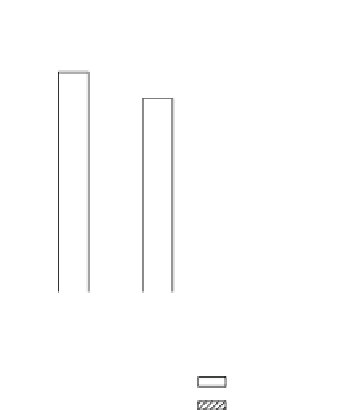Biology Reference
In-Depth Information
Fig. 7.3
Effect of GGOH on
increased [
3
H]taurine uptake
by bisphosphonates in
TR-iBRB cells under high
glucose condition (25 mM).
The cells were pretreated
with 10 mM alendronate (
a
)
and pamidronate (
b
) in the
absence ( ) or the presence
( ) of GGOH for 0.5, 4, 6 h.
[
3
H]Taurine uptake was
performed with ECF buffer
containing [
3
H]taurine (28
nM) for 5 min at 37°C. Each
point represents the
mean ± SEM (
n
= 4).
*
p
< 0.05; **
p
< 0.01,
signi fi cantly different from
the absence of GGOH
100
no GGOH
+ GGOH
80
**
60
**
*
40
20
0
0.5 h
4 h
6 h
100
no GGOH
+ GGOH
80
*
60
*
40
20
0
0.5 h
4 h
and in vivo through translational control (Schrufer et al.
2010
) . A number of
evidences suggest that VEGF, and consequently angiogenesis, is involved in the
pathogenesis of DR (Nicholson and Schachat
2010
) . Therefore, we hypothesized
that VEGF inhibitors can recover the reduced taurine uptake at iBRB. Nitrogen-
containing bisphosphonate drugs are the primary nonsurgical treatment for decreas-
ing osteoclast action in various bone diseases such as Paget's disease, osteoporosis,
and osteogenesis imperfecta. Bisphosphonate drugs are also used extensively to
reduce circulating VEGF, thereby reducing metastasis for many forms of cancer
(Santini et al.
2002
). As a result, alendronate or pamidronate significantly increased
[
3
H]taurine uptake which was reduced by high glucose in TR-iBRB cells (Fig.
7.2
).
The main mechanism by which bisphosphonates alter cellular function is through
inhibition of various enzymes of the mevalonate pathway of isoprenoid lipid
synthesis (Luckman et al.
2005
). One of isoprenoid intermediates, geranylgeranyl
pyrophosphate, is essential for the posttranslational modifications necessary for
membrane anchoring and activation of the small GTP-associated proteins involved
in intracellular signaling. Provision of mevalonate pathway intermediate, GGOH,











































































Search WWH ::

Custom Search